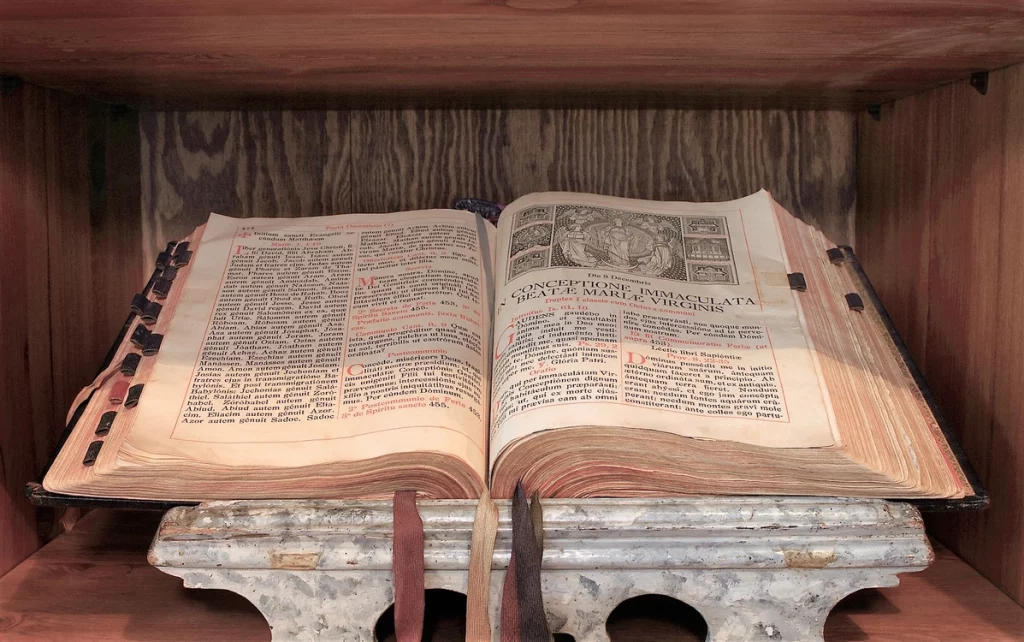that is the opening prayer of the day

The missal which Saint Maximillian Kolbe used
Let’s try to understand individual parts of Holy Mass
In this series of reflections on parts of the Holy Mass, we have considered the Gloria. On Sundays and Feasts, and on weekdays after the act of penitence the prayer of the day (the Collect) follows. This name, collect, comes from the Latin word colligere and means to gather together. In this prayer, the priest gathers the intentions of the faithful participating in the Holy Mass.
The priest first invites the people to pray, saying: “Let us pray”; this call is followed by a moment of silence. What should it be filled with? In the “General Introduction to the Roman Missal” it is written as follows: “All, together with the priest, observe a brief silence so that they may be conscious of the fact that they are in God’s presence and may formulate their petitions mentally.” (54). This silence has a threefold purpose: 1. We realize that God is present here, in a special way; 2. We state the specific intention with which we came to church; 3. We can also pray ourselves, e.g.: “Lord, strengthen my faith.” The priest collects all these intentions spiritually, adds his own and brings them to God.
The structure of the collect, i.e., its structure, is wise and interesting. The collect consists of four parts. At the beginning, the name of God is invoked: God, God the Father, God the Creator, eternal God, God Almighty, etc. Then, God’s works are mentioned according to the liturgical year, i.e., depending on the nature of a given day: a weekday, a memorial, a feast, a solemnity: what God has done for us is mentioned. In the third part of the prayer, specific requests are addressed to God, corresponding to the mystery of a given day. This call also includes the prayers of the faithful expressed in silence. Requests are addressed to God the Father through Jesus Christ in the Holy Spirit. This ending concludes the day’s prayer.
This particular prayer, concise and theologically profound, combines the past (God’s works), the present (our lives) and the future, as we expect God’s gifts. The faithful end the collect by saying: “Amen”, i.e., “so be it, I believe”. In this way, they confirm the content of the prayer and express trust that God will hear them.
Who says this prayer? Of course, a priest. In reality, however, he only lends his mouth to Jesus Christ – because it is Jesus who gathers us in the Eucharist, it is Jesus who brings our prayers to the Father in heaven, it is Jesus who feeds us with His word and body.
Let’s pay our attention to one more feature of this prayer. The priest says it with his hands raised up. In the early Church, everyone prayed this way, which is confirmed by early Christian art (drawings on rocks, in caves, in catacombs). With this gesture, the priest seemed to be saying: “I open my heart, just like these hands, and I surrender myself to You, Lord”; “Fill my empty hands with Your power.” We may remember a certain event from the history of the chosen people. It was during the battle against the Amalekites, Moses prays with raised hands. When they drop due to exhaustion, the enemy begins to win. And what happens then? Aaron and Hur come to Moses and hold up his arms; and ultimately Israel wins (cf. Ex 17:8-13). When we see a praying priest with raised hands during Holy Mass, let us “hold them up” too with our prayer for him. The priest needs the support of the faithful.
The model for accepting human matters and problems and in bringing them to God’s throne was Saint John Bosco. He lived in the 19th century. He was a musically and athletically talented boy, which attracted his peers and had a good influence on them. As a priest, he cared for poor youth. For their upbringing and education, he founded a special institute in Turin. He was once visited by Lord Palmerston, minister to the Queen of England. He was amazed that several hundred boys were sitting in silence in one room doing their homework. When he asked how this was possible, Fr. Bosco replied that his educational method included frequent confession, Holy Communion and daily participation in Holy Mass. Looking at this method of Saint John Bosco it is worth considering, because today it is often difficult for teachers or catechists to maintain peace in classes of twenty-odd children.
Many, including the adults, entrusted Saint John Bosco with their problems and secrets, asking for prayers. During the Holy Mass that John Bosco celebrated, there was a moment of silence during which he, deep in his soul, called by name all the matters that people had entrusted to him, and then in prayer he presented them to God. The faithful knew that their lives found their place in the prayer of the priest John Bosco, at the altar of the high priest of Jesus Christ. And he gave this advice to priests: “Celebrate every Holy Mass as if it were your first Holy Mass, as if it were your last Holy Mass, as if it was your only Holy Mass.”
The priest is the representative of human affairs before God and the mediator of His graces. He knows the requests and needs of so many. In the prayer of the day they are present at the altar and at the same time before God. In confidence let’s entrust them to the priest, and he will accept them into his heart and, with outstretched hands, “send” them to the best Father in heaven through the sacrifice of His Son, Jesus Christ.